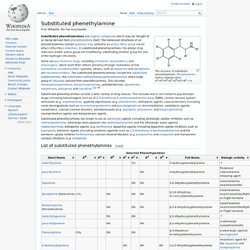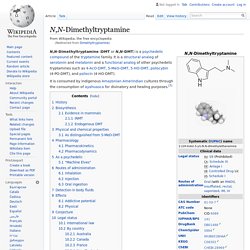

Indolamines. Tryptamine - otherwise known as indolamine.

In biochemistry, indolamines are substituted indole compounds that contain an amino group. Examples of indoleamines include the lysergamides. Synthesis[edit] The pathway for the synthesis of serotonin from tryptophan. Note that all compounds shown are indolamines. In humans, neurotransmitters in the indolamine family are believed to be produced in the pineal gland. See also[edit] References[edit] Jump up ^ Carlson, Neil R. Substituted phenethylamine. The structure of substituted phenethylamines.

Phenethylamine itself is obtained when R 2 =R 3 =R 4 =R 5 =R N =R α =R β = H. Substituted phenethylamines are organic compounds which may be thought of as being derived from phenethylamine itself. The molecular structures of all phenethylamines contain a phenyl ring , joined to an amino (NH 2 ) group via an ethyl (-CH 2 -CH 2 -) sidechain . In substituted phenethylamines, the phenyl ring, sidechain and/or amino group are modified by substituting another group for one of the hydrogen (H) atoms. Synesthesia. Neurological condition involving the crossing of senses Little is known about how synesthesia develops.

It has been suggested that synesthesia develops during childhood when children are intensively engaged with abstract concepts for the first time.[13] This hypothesis – referred to as semantic vacuum hypothesis – explains why the most common forms of synesthesia are grapheme-color, spatial sequence and number form. These are usually the first abstract concepts that educational systems require children to learn. Difficulties have been recognized in adequately defining synesthesia.[14][15] Many different phenomena have been included in the term synesthesia ("union of the senses"), and in many cases the terminology seems to be inaccurate. A more accurate but less common term may be ideasthesia. Types[edit] There are two overall forms of synesthesia: While nearly every logically possible combination of experiences can occur, several types are more common than others. Dimethyltryptamine. N,N-Dimethyltryptamine (DMT or N,N-DMT) is a psychedelic compound of the tryptamine family.

It is a structural analog of serotonin and melatonin and a functional analog of other psychedelic tryptamines such as 4-AcO-DMT, 5-MeO-DMT, 5-HO-DMT, psilocybin (4-PO-DMT), and psilocin (4-HO-DMT). It is consumed by indigenous Amazonian Amerindian cultures through the consumption of ayahuasca for divinatory and healing purposes.[3] History[edit] Another historical milestone is the discovery of DMT in plants frequently used by Amazonian natives as additive to the vine Banisteriopsis caapi to make ayahuasca decoctions. Biosynthesis[edit] Biosynthetic pathway for N,N-dimethyltryptamine This transmethylation mechanism has been repeatedly and consistently proven by radiolabeling of SAM methyl group with carbon-14 (14C-CH3)SAM).[17][19][21][22][23] Evidence in mammals[edit] In 2013 researchers first reported DMT in the pineal gland microdialysate of rodents.[25] Lysergic acid diethylamide. Hallucinogenic drug Lysergic acid diethylamide (LSD), also known as acid, is a hallucinogenic drug.[11] Effects typically include altered thoughts, feelings, and awareness of one's surroundings.[11] Many users see or hear things that do not exist.[12] Dilated pupils, increased blood pressure, and increased body temperature are typical.[13] Effects typically begin within half an hour and can last for up to 12 hours.[13] It is used mainly as a recreational drug and for spiritual reasons.[13][14] About 10 percent of people in the United States have used LSD at some point in their lives as of 2017, while 0.7 percent have used it in the last year.[12] It was most popular in the 1960s to 1980s.[13] LSD is typically either swallowed or held under the tongue.[11] It is most often sold on blotter paper and less commonly as tablets or in gelatin squares.[13] There is no known treatment for addiction, if it occurs.[16] Uses Recreational Pink elephant blotters containing LSD Spiritual Medical Effects Forms.

Hallucinogen.